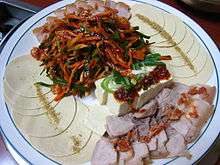Bossam (food)
| Bossam | |
 Bossam | |
| Korean name | |
|---|---|
| Hangul | 보쌈 |
| Hanja | none |
| Revised Romanization | bossam |
| McCune–Reischauer | possam |
Bossam is a pork dish in Korean cuisine. The centerpiece is pork belly, boiled in spices and thinly sliced. The meat is served with side dishes including garlic, onion, ssamjang (wrap sauce), saeujeot (pickled, fermented shrimp) and newly made kimchi. Upon eating, the meat and sides are often wrapped in vegetable leaves such as red lettuce, sesame or napa cabbage, hence the literal meaning of bossam: "wrapped" or "packaged."[1][2]
Bossam is a popular dish in Korea, often served as anju (dishes that accompany alcohol consumption).[3][4]
Origins
Bossam is traditionally linked with the season of gimjang, where large quantities of kimchi were prepared for winter. To ensure the commitment of the workers during this labor-intensive process, noblemen would deliver a pig for a feast. The workers would enjoy boiled pork with some of their newly made kimchi, which, being early in the fermentation process, was a fresh and crispy compliment to the soft pork of bossam.[4]
Preparation
Pork meat is boiled in a broth that contains ginger and onions to reduce the smell. Bossam is often eaten with oyster on top of the meat; this variety is called gul bossam. Gul bossam restaurants also provide gamjatang (pork bone soup), which is traditionally eaten first.[4]
Gallery
-

-

-

-

Myeolchi bossam
See also
References
| Wikimedia Commons has media related to Bossam. |
- ↑ Jung, Alex "5 Korean ways to eat a pig", CNN Go. 11 November 2011. Retrieved 2012-04-11
- ↑ "The Bo Ssam Miracle". The New York Times. 2012-01-12. Retrieved 2013-04-05.
- ↑ "Bossam's continuous popularity" Money & Business. 12 May 2010. Retrieved 2010-06-23 (Korean)
- 1 2 3 "Episode 18: Jongno 3(sam)-ga's Gul Bossam Alley". Visit Seoul. Retrieved 16 April 2013.